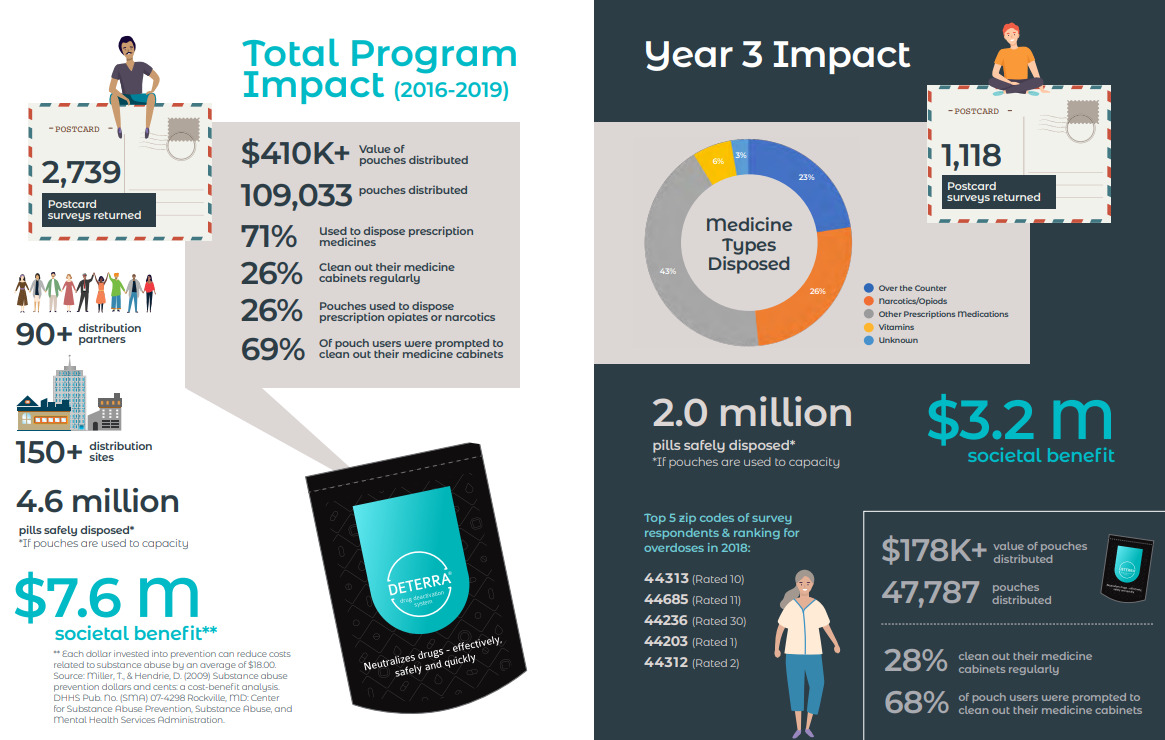4 steps to measure the success of an at-home drug deactivation and disposal campaign
Learn how organizations use data to show the ROI of Deterra
By: John Oldenkamp, Chief Revenue & Financial Officer and Board Member at Verde Environmental Technologies, Inc.
In the finance world, decisions almost always come down to one question: what’s the ROI?
After over 30 years in finance and sales leadership, I know how vital answering that question is to securing support and resources for your goals. However, ROI is not as simple as money in/results out – especially when it comes to prevention.
So how do we measure the impact of providing prevention tools like the Deterra® Drug Deactivation and Disposal System to your community? Here, I’ll share examples of how community-based organizations and healthcare providers have demonstrated the value of at-home drug deactivation and disposal campaigns and the four-step process you can use to assess the success of your efforts.
Here are the four steps we’ll use to measure the success of your prevention campaign:
- Select Evaluation Criteria
- Collect Relevant Data
- Analyze Your Findings
- Share the Results
The 4-step process for measuring ROI of at-home drug deactivation and disposal

The 4-step plan to measure the success of an at-home drug deactivation and disposal campaign. Click here to open an expanded view in a new tab.
Step 1: Determine the Criteria for Success
First, you’ll need to define your objectives and determine what success means for your campaign. Common goals for an at-home drug deactivation and disposal campaign include:
- Increasing proper drug disposal behavior
- Removing a certain number and/or type of drugs from circulation
- Reducing drug-related incidents and overdoses
- Raising awareness about the importance of drug deactivation and disposal
Setting SMART goals for your campaign can help clarify and focus your efforts. SMART goals are Specific, Measurable, Achievable, Relevant, and Time-bound. For example, if you want to increase the proper disposal of unused opioids in your community, your SMART goal might be:
“By [DATE], we’ll distribute [NUMBER] Deterra Pouches and educational materials about proper drug disposal to [NUMBER] community members via community events and direct-to-household mailings.”
For more on SMART goals, see the Deterra Grant Guide.
Once you’ve defined your goals, it’s time to collect data.
Step 2: Collect Relevant Data
To measure the success of your campaign, you’ll need to gather data. Depending on your campaign goals, this could be public data such as the number of drug-related ER visits in your county or information collected from campaign participants.
Including a simple online survey or mail-back questionnaire with your Deterra Pouch distribution is a valuable way to collect data. For example, to determine how Deterra Pouch recipients in Summit County, Ohio were using the pouches, the Summit County Community Partnership (SCCP) distributed a mail-back postcard with questions about past drug disposal habits, frequency of medicine cabinet cleanouts, and the types of medication being disposed of in the pouch.
For healthcare providers, conducting a study is a common method of data collection. For instance, to find out if providing Deterra Pouches increased the proper disposal of unused opioids, Inspira Health provided some patients with education on safe opioid use and a Deterra Pouch while a control group received standard discharge instructions. Both groups were surveyed about their disposal behavior and their responses were compared to determine the campaign’s impact.
Step 3: Analyze Your Findings
Evaluate the data you’ve collected to see the impact of your campaign. Look for patterns and trends in the data to identify areas where the campaign has been successful and areas where it needs improvement.
Tie your findings back to your goals: Did the rate of proper disposal improve? Did the number of unused opioids in your community decrease?
In Summit County, the survey data showed 68% of respondents said receiving Deterra prompted them to clean out their medicine cabinets, compared to only 28% who regularly do so. At the county level, overdose deaths decreased by 56%. As the Deterra campaign expanded beyond Summit County to a seven-county region, Ohio improved from having the second-highest overdose death rate in the country to the fifth-highest.
Inspira Health’s study found over 46% of the intervention group properly disposed of unused opioids compared to 14% of the control group. In addition, intervention group members reported they used Deterra to deactivate and dispose of other household medications.
Step 4: Share The Results
Communicate your findings with key stakeholders, including funders, community partners, and campaign participants. Present your data in a format that speaks to your audience, such as a formal report or an educational infographic.

Summit County Community Partnership created an illustrated brochure to share the results of its Deterra Pouch distribution.
Put the Process into Practice
Measuring the success of a drug misuse prevention campaign takes time and determination, but it’s crucial to ensure that your efforts are having the intended impact. By following the steps outlined above, you can evaluate the effectiveness of your campaign and make data-driven decisions to improve it.
We can provide you with a free custom assessment to help your organization estimate the impact of an at-home drug deactivation and disposal campaign, including potential savings on healthcare and criminal justice costs. Contact us for a custom report and to learn more about how our Valued Added Services can help you collect survey data, track campaign metrics and more.
***

About the Author
John Oldenkamp, MBA, CPA (inactive) is the Chief Revenue and Financial Officer and a Board Member at Verde Environmental Technologies, Inc., creator of the Deterra Drug Deactivation and Disposal System. Prior to joining Verde Technologies, he served as Vice President of Global Retail, Finance and Operations at Starkey Hearing Technologies, where he was instrumental in the redesign of the company’s global retail brand. John holds a B.A. in Accounting and an MBA in Finance/Management from the University of St. Thomas.
Read Next
Learn more about how organizations nationwide use Deterra to make a difference in the fight against prescription drug misuse.

Opioid Settlement Funding Options
Opioid settlement funds provide local leaders with an opportunity to add evidence-based tools like the Deterra System to prevention efforts.

Increase Access to Safe Disposal
Learn how an Ohio coalition distributed over 140,000 Deterra Drug Deactivation and Disposal Pouches in the community to reduce opioid misuse.

Top 10 Ways to Distribute Deterra
Creative tips and distribution tactics to get at-home drug deactivation and disposal resources into the hands of those who need it most.
